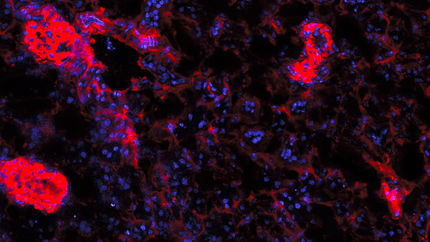New 'biofactories' produce rare healing substances in the endangered Devil's claw plant
Advertisement
Deep in Africa's Kalahari Desert lies the "Devil's claw," a plant that may hold the key to effective treatments for arthritis, tendonitis and other illnesses that affect millions each year. Unfortunately, years of drought have pushed the Devil's claw toward extinction, so scientists are scrambling to devise new ways to produce the valuable medicinal chemicals of the Devil's claw and other rare plants.
One group of scientists reported a major advance toward that goal at the 238th National Meeting of the American Chemical Society (ACS). They described the first successful method of producing the active ingredients in Devil's claw — ingredients that have made the Devil's claw a sensation in alternative medicine in Europe. Their technique may eventually lead to the development of "biofactories" that could produce huge quantities of rare plant extracts quickly and at little cost.
Milen I. Georgiev, Ph.D., who delivered the report, pointed out that for thousands of years, native populations in Southern Africa have used the Devil's claw as a remedy for a huge number of ailments, including fever, diarrhea and blood diseases. Today, there are dozens of medicinal and herbal products around the world that are based on chemicals derived from the Devil's claw.
In particular, studies suggest that two chemicals — the so-called iridoid glycosides harpagoside and harpagide — may have beneficial effects in the treatment of degenerative rheumatoid arthritis, osteoarthritis, tendonitis, and other conditions, Georgiev said.
Currently, more than 25 percent of all prescribed medicines used in industrialized countries are derived either directly or indirectly from plants, many of which are rare and sometimes endangered. "Hairy root," an infectious plant disease caused by the soil bacteria Agrobacterium rhizogenes, is at the core of a promising new technique that could one day lead to "biofactories" that produce medicines derived from rare plants in huge quantities at a low cost. Georgiev notes that hairy roots are a big improvement over traditional, greenhouse-based plant culturing.
"The transformed root cultures possess fast growth rates, genetic and biochemical stability and the capacity for synthesis of plant metabolites. It should be also mentioned that the amount of active metabolites in naturally grown plants in greenhouses significantly vary seasonally," notes Georgiev. Hairy root biofactories, on the other hand, could produce consistently high levels of plant metabolites year round.
Georgiev and his team are the first to induce hairy root cultures of Devil's claw. They took the roots of the Devil's claw and infected them with the A. rhizogenes soil bacteria — a natural genetic engineer — to create a system of hairy roots to produce the plant's key medicinal chemicals. Their studies demonstrated stable growth and high production of both iridoid glycosides harpagoside and harpagide. Previous studies were only capable of producing one of these two compounds. Georgiev notes that there is a long way to go before hairy root biofactories become commercialized, but he hopes to make the technology ready for use within a few years.
























































